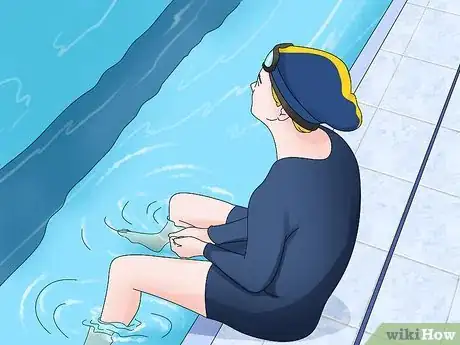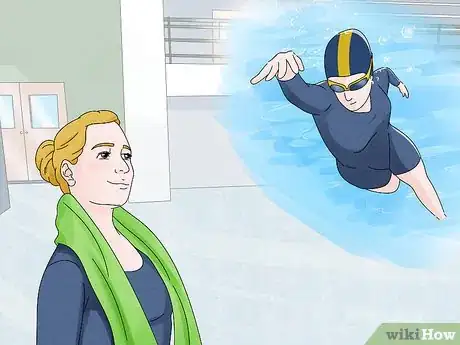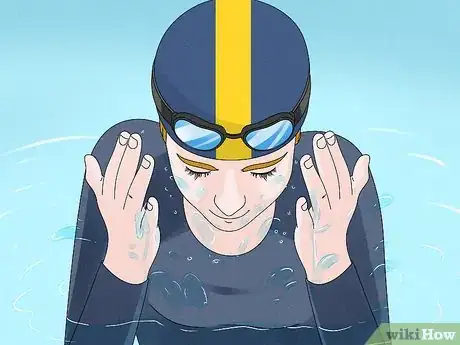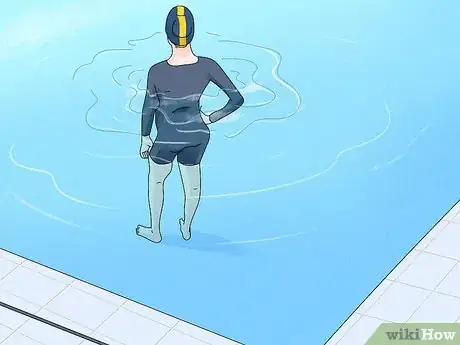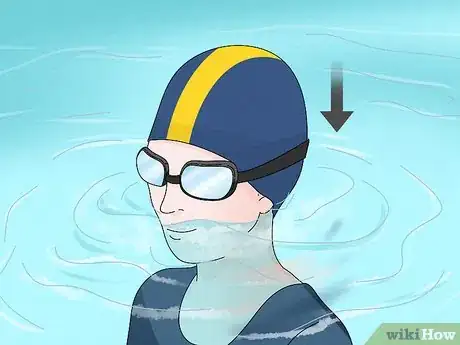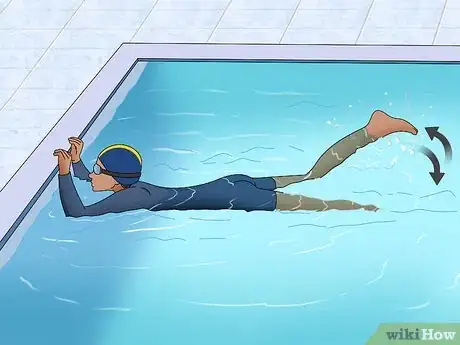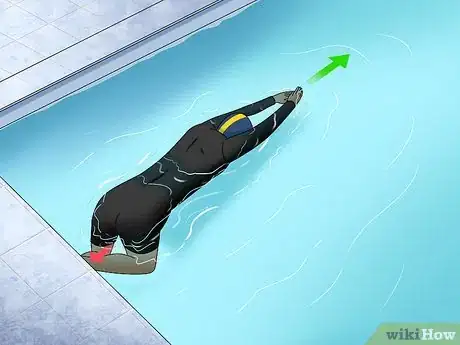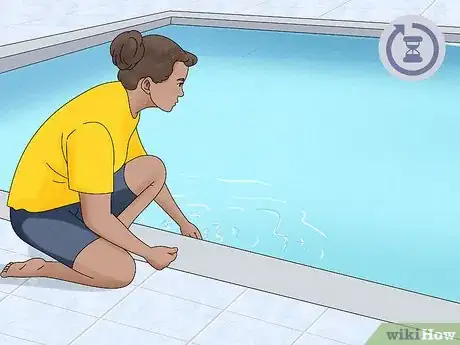This article was co-authored by Brad Hurvitz. Brad Hurvitz is a Certified Swimming Instructor for My Baby Swims, an adolescent swimming school based in La Jolla, California. Brad is trained as an Infant Swimming Resource (ISR) instructor with ISR's Self-Rescue® program. He specializes in training children aged six months to six years of age survival skills like floating on their back to breathe and swimming back to the wall, while also educating parents on how to better keep their kids safe. He has a Master of Business Administration from Oregon State University.
wikiHow marks an article as reader-approved once it receives enough positive feedback. In this case, 89% of readers who voted found the article helpful, earning it our reader-approved status.
This article has been viewed 121,182 times.
If you're afraid of learning how to swim, you're not alone. A lot of people are afraid of swimming or even just getting in the water to learn how. The good news is that it's totally possible to overcome a fear of learning how to swim and get to a point where you're confident in the water. If you're not sure how to get started, don't worry—this article will walk you through a variety of different strategies you can use to become more comfortable in the water at your own pace.
Steps
Sit on the edge of the pool and dangle your legs in the water.
-
Get your feet wet before you get into the water. Stand or sit at the edge of the pool. Dip your toes into the water and then sink your whole foot into it to feel the water on your skin. When you feel comfortable, try sitting on the ledge of the pool and letting your feet and legs hang down into the water. Swirl your legs around to feel the sensation of the water moving around your skin.[1] X Research source
- Try kicking back and forth to feel the motion of swimming.
Start a swimming lesson outside of the pool.
-
Establish trust with your instructor before you even get in the water. Work with an instructor or an experienced swimmer. Begin your lessons outside of the pool and focus on the basic mechanics of swimming so when you do get into the water, you have an idea of what to expect and what to do.[2] X Research source
Practice relaxation techniques and visualization.
-
Calm your mind and imagine yourself swimming before you get in the water. Learning to swim can be a scary experience. Take deep, controlled breaths to help settle your nerves and reduce your anxiety. Picture yourself in the water swimming around and visualize using the swimming techniques you learned in your lessons.[3] X Research source
Splash some water in your face and think positive thoughts.
-
Associate happy things with water to help reduce your fear. Scoop up some water into your hands like a bowl. Gently splash or rub the water onto your face to see what it feels like without having to submerge your head. When you splash the water, think about positive images to associate good things with swimming.[4] X Research source
- For example, you could think about having fun with your friends at a pool party. You could also think about something that’s not at all related to water, such as petting your dog, playing your favorite video game, or even munching on your favorite snack.
Get into shallow water if you feel comfortable.
-
Take it slow and move into gradually deeper water. If you’re in a pool with a shallow end, try wading out into the water. Stand where the water is at a comfortable level such as your waist. As you feel more comfortable, try walking up to chest or even neck level. Stick to your comfort zone and just enjoy the feeling of being in the water.[5] X Research source
- According to Certified Survival Swimming Instructor Brad Hurvitz, if you want to learn to swim but you're hesitant about being in the water, start with small steps, and celebrate your successes. For instance, one day, you might just dip your face into the water, and the next time, you might open your eyes underwater. That way, you can gradually reduce your fears while still building a healthy respect for the environment.
Submerge your head beneath the water when you feel ready.
-
Hold your breath and slowly crouch down. Stand in a comfortable and stable stance in the water. Slowly bend your knees to crouch down and submerge your face up to your lips in the water. Then, when you feel okay with it, try lowering down to your nose or eye level. If you feel alright, hold your breath and submerge your whole head in the water so you feel more comfortable about it.[6] X Research source
- Sometimes the idea of fully submerging your head underwater can seem scary. But you can try to overcome your fear by taking it slow.
- If you feel really anxious or worried, you don’t have to put your whole head underwater. Try working your way up to it.
Blow bubbles while you’re underwater.
-
Stay under the surface and let out some air. Try sitting at the bottom for a little while. Blow air out of your mouth to make bubbles and get more comfortable with the sensation of being fully underwater. The more comfortable you feel being underwater, the less afraid you’ll be about learning to swim.[7] X Research source
- Blowing bubbles is commonly used to help kids get used to putting their face in the water.
Hold onto the side and practice kicking.
-
Stretch yourself out and practice the motion of swimming so it’s less scary. Stand near the edge of the pool and grab hold of the ledge. Sink down into the water and stretch yourself out completely like you’re swimming. Then, kick your legs up and down like you’re swimming through the water to get used to the feeling.[8] X Research source
- If you’re working with an instructor or an experienced swimmer, have them check your kicking technique to make sure you’re doing it right.
Have a friend tow you around.
-
Extend your arms and allow them to pull you around the pool. Keep your face in the water and kick your feet as they pull you around to get used to the feeling of swimming, which can make you feel less afraid. Have your friend or swimming instructor tow you for a few laps around the pool.[9] X Research source
Glide through the water when you’re ready.
-
Push off the wall or have a friend tow and release you. Stand near the wall, submerge yourself in the water, and kick off the wall. Allow yourself to glide over the water. You could also try kicking your legs to practice swimming. If you’re working with a friend or swimming instructor, have them tow you around and then release you so you can glide while they’re nearby to help if you need it.[10] X Research source
- Once you feel comfortable gliding over water by yourself, you may be ready to take on some swimming lessons without fear!
Go slow and understand that it may take time.
-
You can eventually move past your fear of the water. Lots of people are nervous or afraid about water, especially if they don’t know how to swim. It’s okay. It may take some time and work, but if you stick to it, you absolutely can move past your fear and learn to swim like a pro.[11] X Research source
Warnings
- If you’re brand new to swimming, work with an instructor or an experienced swimmer who can help you if you have trouble in the water.⧼thumbs_response⧽
You Might Also Like











References
- ↑ https://www.enjoy-swimming.com/overcoming-fear-of-water-1.html
- ↑ https://www.psychologytoday.com/us/blog/some-nerve/201412/how-overcome-fear-water
- ↑ https://www.psychologytoday.com/us/blog/some-nerve/201412/how-overcome-fear-water
- ↑ https://www.swimming.org/learntoswim/tips-to-help-overcome-a-fear-of-swimming/
- ↑ https://www.whitefishwave.com/2021/01/7-tips-for-overcoming-a-fear-of-swimming/
- ↑ https://www.enjoy-swimming.com/overcoming-fear-of-water-1.html
- ↑ https://www.enjoy-swimming.com/overcoming-fear-of-water-1.html
- ↑ https://www.swimming.org/learntoswim/tips-to-help-overcome-a-fear-of-swimming/
- ↑ https://www.enjoy-swimming.com/overcoming-fear-of-water-1.html
About This Article

